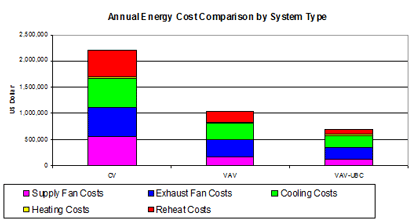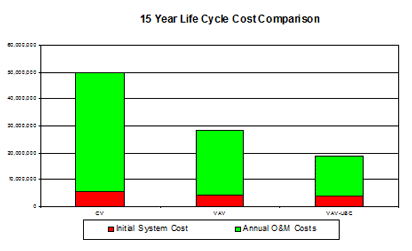|
|

Laboratories typically consume 5 to 10 times more energy than a commercial building of similar size and approximately 50% of that cost is attributed to ventilation. This is because laboratories and research facilities require 100% single-pass outside air for ventilation 24 hours a day, 365 days per year - supply air in laboratories cannot be re-circulated. Single pass air is costly, there are:
- Annual cooling energy costs
- Annual heating energy costs
- Annual reheat energy costs
- Annual supply air handler (AHU) energy costs
The cost to produce 100% outside single pass air in San Diego (for example) is approximately $6.47 per cubic feet per minute (CFM) per year (for air cost calculations in your area see the LABORATORY FUME HOOD ENERGY MODEL calculator - Lawrence Berkley National Lab website: http://fumehoodcalculator.lbl.gov/
For a lab with fume hoods the cost of energy is even higher. A single 8’ fume hood consumes approximately 1750 CFM constantly (if you don’t use a variable volume system). Some buildings have 200+ fume hoods. Let’s do the math:
200 hoods x 1750 CFM/hood x $6/CFM/year =
$2,100,000 per year.
At $0.165/kilowatt hour (kWh) that =
12,000,000 kWh per year.
A Phoenix Controls variable air volume system can significantly reduce these costs.
The following is a real world example of how a major pharmaceutical company decided to use the Phoenix Controls variable air volume laboratory airflow controls systems as they expanded one building to a seven building campus:
- A major pharmaceutical company had bought a local biotech company in San Diego, and was planning on adding seven buildings to an existing campus.
- The existing campus had one (1) 80,000 square foot building.
- Their plan was to expand the campus to comprise 1 million square feet of research space.
- The biotech company had standardized on a competitor to Phoenix Controls.
- They had also used a competitor to the Phoenix Controls system for laboratory fume hood and space pressurization control.
- Their new parent company (and the local engineer) had other thoughts for the new facilities.
- While designing their new building, they chose to design around Phoenix Controls.
- Phoenix Controls provides superior capture and containment at the fume hood.
- Phoenix Controls provides superior space pressurization control.
- Phoenix Controls requires no recommended routine maintenance.
- Phoenix Controls provides superior VAV savings (due to its higher turndown).
- Phoenix Controls provides dramatic operating cost savings due to its unique fume hood presence sensor.
As the bids were being evaluated, two important elements came to light:
- The actual airflows of their existing (“other”) fume hood control system were measured, and
- An energy analysis was prepared using LabPro™ software to evaluate the comparative operating costs of each system.
- When actually measured, the overall turndown (the ratio of maximum exhaust flow to minimum exhaust flow) of their existing system was only 2:5 to 1.
- With the Phoenix Controls system, the overall turndown would be 5:1.
- This means that any operating savings of a “another” VAV system would only be half of what the operating savings would be for a Phoenix Controls VAV system.
- LabPro allowed them to model their building with 150 fume hoods to see how it would operate in the light of varying user presence, sash movement, and thermal demands.
- After the model was created, the following results were produced:
CV – Constant Volume, compared with:
CV – PHX – Phoenix Controls constant air volume system
VAV – Variable air volume
VAV-PHX – Phoenix Controls variable air volume system
CV-UBC – Constant volume using Usage Based Controls (UBC) on the fume hoods
VAV-UBC – Variable air volume using Usage Based Controls (UBC)
LabPro Flow Summary
| |
Unit |
CV |
CV-PHX |
VAV |
VAV-PHX |
CV-UBC |
VAV-UBC |
| Design Exhaust System Flow |
CFM |
310,167 |
310,167 |
212,415 |
212415 |
231,885 |
173,616 |
| Average Exhaust System Flow |
CFM |
310,167 |
310,167 |
175,972 |
175,972 |
198,341 |
131,398 |
LabPro Energy Cost Comparision (annual)
| Annual Cooling Energy Cost |
USD |
538,941 |
538,941 |
306,393 |
306,393 |
346,577 |
226,317 |
| Annual Heating Energy Cost |
USD |
38,215 |
38,215 |
19,341 |
19,341 |
22,318 |
13,410 |
| Annual Reheat Energy Cost |
USD |
501,730 |
501,730 |
200,724 |
200,724 |
250,899 |
100,742 |
| Annual Supply AHU Energy Cost |
USD |
556,625 |
556,625 |
188,608 |
188,608 |
230,321 |
116,787 |
| Annual Exhaust Fan Energy Cost |
USD |
567,077 |
567,077 |
321,729 |
321,729 |
362,626 |
240,234 |
| Total Annual Energy Cost |
USD |
2,202,588 |
2,202,588 |
1,036,795 |
1,036,795 |
1,212,740 |
697,490 |
As you can see, the existing building with the constant volume (CV) airflow controls system was designed to produce 310,167 CFM of exhaust with a total annual energy cost of over $2.2M. If the building were designed with a Phoenix Controls variable air volume system with Usage Based Controls (VAV-UBC), design exhaust flow would be 173,616 CFM and an annual energy cost of $697,490. This was a significant enough savings for the biotech company to design the expansion of 1 million square feet of new lab space with a Phoenix Controls variable air volume system with Zone Presence Sensors (usage based controls).
Converting constant volume mechanicals systems with more energy efficient variable air volume controls can save significant amounts of energy and in many cases retrofit projects will be considered for incentives by Utilities. See Newmatic Engineering Utility Incentives


As you can see,
Solutions:
- Changing constant volume (CV) systems to Phoenix Controls variable air volume (VAV) systems for more energy-efficient, safe, reliable, quiet and science-friendly control.
- Upgrading fume hood controls to Phoenix Controls with Zone Presence Sensors® (ZPS). ZPS units modulate hood flows based on the presence or absence of a fume hood operator. ZPS technology can be used in both two-state and variable air volume applications.
|

|






